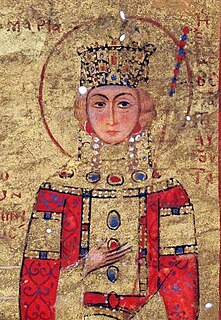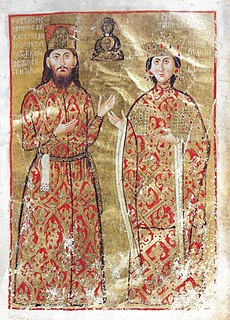Related Research Articles

Andronikos II Palaiologos, usually Latinized as Andronicus II Palaeologus, reigned as Byzantine Emperor from 1282 to 1328. Andronikos' reign was marked by the beginning of the decline of the Byzantine Empire. During his reign, the Turks conquered most of the Western Anatolian territories of the Empire and, during the last years of his reign, he also had to fight his grandson Andronikos in the First Palaiologan Civil War. The civil war ended in Andronikos II's forced abdication in 1328 after which he retired to a monastery, where he spent the last four years of his life.
This is an alphabetical index of people, places, things, and concepts related to or originating from the Byzantine Empire. Feel free to add more, and create missing pages. You can track changes to the articles included in this list from here.
Komnenos is a Byzantine Greek noble family who ruled the Byzantine Empire from 1081 to 1185, and later, as the Grand Komnenoi founded and ruled the Empire of Trebizond (1204–1461). Through intermarriages with other noble families, notably the Doukai, Angeloi, and Palaiologoi, the Komnenos name appears among most of the major noble houses of the late Byzantine world.

Maria of Antioch (1145–1182) was a Byzantine empress by marriage to Byzantine Emperor Manuel I Komnenos, and regent during the minority of her son porphyrogennetos Alexios II Komnenos from 1180 until 1182.

Alexios II Megas Komnenos, was Emperor of Trebizond from 1297 to 1330. He was the elder son of John II and Eudokia Palaiologina.
John Doukas, Latinized as Ducas, was the eldest son of Constantine Angelos by Theodora Komnene, the seventh child of the Byzantine Emperor Alexios I Komnenos and Irene Doukaina. John Doukas took the family name of his grandmother Irene. He served as a military commander under Manuel I Komnenos and Isaac II Angelos. Isaac II, who was Doukas's nephew, raised him to the high rank of sebastokrator. Despite his advanced age, he continued to be an active general in the 1180s and 1190s, and until shortly before his death aspired to the imperial throne. He was the progenitor of the Komnenos Doukas line, which founded the Despotate of Epirus after the Fourth Crusade.
The Angelos family, feminine form Angelina (Ἀγγελίνα), plural Angeloi (Ἄγγελοι), was a Byzantine Greek noble lineage which rose to prominence through the marriage of its founder, Constantine Angelos, with Theodora Komnene, the youngest daughter of Emperor Alexios I Komnenos. As imperial relatives, the Angeloi held various high titles and military commands under Emperor Manuel I Komnenos. In 1185, following a revolt against Andronikos I Komnenos, Isaac II Angelos rose to the throne, the first of three Angeloi emperors who ruled until 1204. The period was marked by the decline and fragmentation of the Byzantine Empire, culminating in its dissolution by the Fourth Crusade in 1204.
Andronikos Palaiologos or Andronicus Palaeologus may refer to:
Manuel Komnenos was the eldest son of Byzantine emperor Andronikos I Komnenos, and the progenitor of the Grand Komnenos dynasty of the Empire of Trebizond. He served his uncle, Manuel I Komnenos, as a diplomatic envoy to the Russian principalities and the Kingdom of Jerusalem, but also helped his father escape imprisonment in Constantinople. His opposition against the regency of Empress-dowager Maria of Antioch and the protosebastos Alexios Komnenos landed him in prison, but he was released in April 1182, when his father stood poised to take power in the Byzantine capital.
George Palaiologos or Palaeologus was a Byzantine general, one of the most prominent military commanders and supporters of Emperor Alexios I Komnenos.

The mesazōn was a high dignitary and official during the last centuries of the Byzantine Empire, who acted as the chief minister and principal aide of the Byzantine emperor.
Theodora Komnene was a Byzantine noblewoman, being the fourth daughter of Emperor Alexios I Komnenos and Irene Doukaina. She married Constantine Angelos, by whom she had seven children. Byzantine emperors Alexios III Angelos and Isaac II Angelos were her grandsons, thereby making her an ancestor of the Angelos dynasty.
The Raoul was a Byzantine aristocratic family of Norman origin, prominent during the Palaiologan period. From the 14th century on, they were also known as Ral[l]es (Ῥάλ[λ]ης). The feminine form of the name was Raoulaina (Ῥαούλαινα).

Theodore Komnenos Doukas Palaiologos Synadenos, usually simply Theodore Synadenos, was a Byzantine magnate, senior official and military leader of the early 14th century, who played an important role in the civil wars of the period. The scion of a noble lineage, he became one of the first and most prominent supporters of Andronikos III Palaiologos in his struggle against his grandfather Andronikos II. Synadenos held various provincial governorships during Andronikos III's reign, including Epirus and Thessalonica. After the outbreak of the civil war of 1341–1347, he tried to surrender Thessalonica to his old friend John Kantakouzenos, but was driven from the city by the Zealots of Thessalonica. Forced to join Kantakouzenos's enemies, he was initially honoured with the high rank of protovestiarios but soon placed under house arrest in Constantinople, where he died impoverished in 1345 or 1346.
Constantine Angelos was a Byzantine aristocrat who married into the Komnenian dynasty and served as a military commander under Manuel I Komnenos, serving in the western and northern Balkans and as an admiral against the Normans. He was the founder of the Angelos dynasty, which went on to rule the Byzantine Empire in 1185–1204 and found and rule the Despotate of Epirus (1205–1318) and the Empire of Thessalonica (1224–1242/46).
John Komnenos was the second son of the Byzantine aristocrat, and emperor in 1183–1185, Andronikos I Komnenos. His father appointed him co-emperor over his older brother Manuel, but when Andronikos was deposed on 12 September 1185, John was also seized and probably killed.

Mutinensis gr. 122 is a 15th-century codex written in Greek, stored in the Biblioteca Estense in Modena, Italy. The designation "Mutinensis gr. 122" is modern, the codex itself bearing the title Epitome of Histories as it contains a copy of the work of the same name by the 12th-century Byzantine historian Joannes Zonaras. Zonaras's work is a chronicle of world history, focusing on the Roman and subsequent Byzantine Empire up until the ascension of Emperor John II Komnenos in 1118. The Modena codex also features additional work by two later scribes, extending the codex to cover Byzantine history after John II up until the Fall of Constantinople in 1453.

George Palaiologos Doukas Komnenos was a high-ranking Byzantine aristocrat and diplomat of the 12th century. A kinsman of the ruling Komnenos dynasty, George Palaiologos held the rank of sebastos and the office of megas hetaireiarches. His son Alexios was briefly heir-apparent to Emperor Alexios III Angelos, and his great-grandson Michael VIII Palaiologos founded the Palaiologan dynasty of Byzantine emperors.